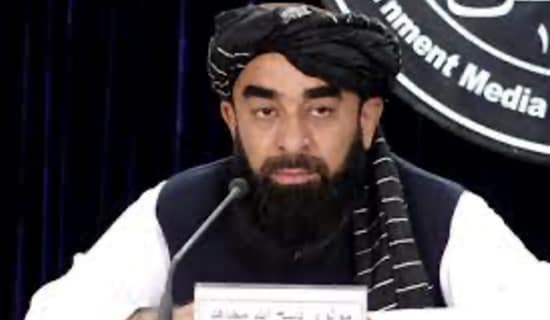On September 13, 2016, The New York Times published an op-ed by Iranian Foreign Minister Mohammad Javad Zarif titled "Let Us Rid the World of Wahhabism."[1] In it, Zarif harshly attacked Wahhabism, the branch of Sunni Islam espoused by the Saudi regime, calling it a "death cult" and a "theological perversion" of Islam that is the origin of all terrorist organizations including Al-Qaeda, the Taliban, Boko Haram, Jabhat Al-Nusra (formerly Al-Qaeda's Syria branch, now called Jabhat Fath Al-Sham), and ISIS. He accused Saudi leaders of spending tens of billions of dollars in recent decades in order to export this Wahhabi ideology to the Muslim world and to the world at large. He called on the UN and the international community to cut off the routes used to fund "ideologies of hate and extremism" and investigate how money and arms are delivered to the followers of these ideologies.
Zarif tweet advertising his New York Times article (Twitter.com/JZarif, September 14, 2016)
In response to Zarif's article, Saudi Foreign Minister 'Adel Al-Jubeir published his own op-ed in the Wall Street Journal arguing that it is Iran who, ever since the onset of Khomeini's revolution, has been striving to spread its revolutionary ideology by sparking sectarian and religious conflict, bluntly interfering in the affairs of other countries, aiding terrorist organizations including Al-Qaeda, and carrying out terrorist attacks around the world. According to Al-Jubeir, Iran's false propaganda regarding its fight against extremism cannot whitewash its record of "death and destruction," whose results are currently visible in Syria and Iraq. He argued that Saudi Arabia is one of the leaders in the global war against terrorism, and would improve relations with Iran if the latter ended its support for terrorism and "subversive and hostile" actions, ceased interfering in the affairs of other countries, and respected its neighbors.[2]
Jubeir tweet advertising his Wall Street Journal article (Twitter.com/AdelAljubeir, September 18, 2016)
Furious responses to Zarif's article also appeared in the official Saudi media. The Saudi press featured numerous articles condemning Zarif and accusing him of participating in a campaign aimed at blackening Saudi Arabia's name in the world, accusing it of supporting terrorism, and sparking conflict within the Sunni world. Some articles criticized the absence of Saudi informational efforts to combat Iran's growing influence on global discourse, and called to expose Iran's oppression of its own people and its sponsorship of terror organizations in the Arab world, while highlighting the tolerance and coexistence in Saudi society. One article stated that the publication of Zarif's article in a paper as prominent as The New York Times indicates that the Americans have traded in their traditional allies for Iran.
The following are excerpts from some of these articles:
Editor Of Saudi Daily: Iranian Propaganda Agents Infiltrate Institutions Influencing Global Public Opinion
'Abd Al-Wahhab Al-Fayez, chief editor of the official Saudi daily Al-Yawm, condemned Zarif's allegation that Saudi Arabia supports terrorism, and called to expose Iran's oppression of its own people and its crimes in Arab countries. He wrote: "The article by Iranian Foreign Minister Javad Zarif in The New York Times is part of the ongoing propaganda and political ideologization program of the Khomeinist revolution. This propaganda has skillfully managed to create a rift among Arab Shi'ites, and is now working to divide Sunnis by lying about the Wahhabi [stream] and making it the focus of the Iranian propaganda spread by politicians, clerics, researchers at Western centers, and civil society activists.
"Sadly, the Iranian propaganda program, which aims to create a link between Saudi Arabia and Wahhabism and between Wahhabism and terrorism, finds an audience and influences discourse. This is happening after we abandoned the scene to the Iranian propaganda agents, who infiltrate authoritative institutions that influence local and international public opinion - particularly global newspapers and TV and radio networks.
"Iran's strength does not [really] lie in what it spreads and markets about others - specifically the lie regarding Saudi Arabia and its alleged support of terrorism - because [Iran itself] lives in a glass house [and is vulnerable] on many issues, and is the target of condemnation by international institutions. In fact, its allied parties and subordinate militias carry out terrorism and ethnic cleansing in Iraq, Syria, Lebanon, and Yemen, and the oppressive Khomeinist security apparatuses similarly operate against Arabs in the Al-Ahwaz [region], both Shi'ites and Sunnis.
"This commotion caused by Iran resonates [only] because it operates freely in a vacuum and without any resistance! Of course, reality proves that the rope of lies is short and slack, which is also true for [its lies regarding] us in the region, as we have already exposed the biggest Khomeinist lie. However, we must help the peoples with whom we have good relations and positive interests to quickly expose the Iranian lie for themselves."[3]
Saudi Columnist: "Political Dwarf" Zarif Ignores His Own Country's Bloody Record
Similar criticism of Zarif was also expressed by Saudi writer Fahd bin Jleid in his column in the official Saudi daily Al-Jazirah. He wrote: "Mohammad Zarif penned his article of racism, hatred, and lies... which was published in The New York Times, in order to divert the world's attention towards a new artificial struggle among Sunnis. This is part of a long-term anti-Islamic Persian plot. In his article, this political dwarf ignored the black and bloody record of his own country, which fosters and funds the leaders of terrorist [groups] like Al-Qaeda, Hizbullah, and ISIS, as well as its evil plots to spread the poisons of sectarianism and hatred in Lebanon, Iraq, Syria, Yemen, Afghanistan, Pakistan, Bahrain, and more...
"Zarif's statements in his article are nothing but another Iranian step meant to distort Saudi Arabia's image in global public opinion, while exploiting loopholes in global free speech, as happened in The New York Times. Therefore, we must not simply make do with an identical response [article] in the same newspaper... We must confront with this plot with a series of corrective steps, including by publicizing [Saudi] activity in the fields of culture, art, sports, and society, activity that reflects the real picture: the tolerant [nature] of the Saudis, their life in coexistence, and their peaceful disposition and religion - in contrast to the image spread by Iran and its helpers around the world.
"Iran is currently experiencing a crisis and isolation in the Islamic world after its great Hajj plot failed. Its true place and status among Muslims was exposed when no one attributed much significance to its absence from Hajj ceremonies this season, viewing it instead as Iranian political stupidity.[4] This prompted it to mobilize all its efforts to create new battles and spark fires among various schools in Islam in order to harm the image of the [Saudi] kingdom using international platforms."[5]
Saudi Columnist: Zarif's Article Indicates That The U.S. Is Trading In Its Traditional Allies For Iran
Salem bin Ahmed Sahab, a columnist for the official Saudi daily Al-Madina, claimed that the publication of Zarif's article in The New York Times indicates that the American administration has traded in its traditional allies for Iran. He wrote: "Last Wednesday, the reputable American newspaper The New York Times published an op-ed by Iranian Foreign Minister Mohammad Javad Zarif, in which he attacked Saudi Arabia... There is no reason to accuse Zarif, the new Safavid, for the publication of his apostasy and lies, lowly as they may be. The accusation should be directed solely at the newspaper, which is considered the most important for decision-makers in the country of Uncle Sam. [And] the worst accusation should be directed at us Arabs, if we think that the appearance of this stupid article was a coincidence or an accident, or that there is some measure of regret there - for [we should have known] that this is not the case at all! The article would have been published even if we had proven [in advance] that it was rife with lies, nonsense, and twisted facts...
"This is an [American] policy of washing one's hands of old allies in favor of shaking hands with new ones. The goal is to destroy the region in order to eradicate the Sunnis, or at the very least crush them so they can never experience revival, prosperity, development, or might. No one is more suited for this despicable task than those with the darkest record of long-term collaboration with the enemies of the ummah - the deviant, hostile, infidel, Shi'ite Zoroastrian Safavids!"[6]
Endnotes:
[1] Nytimes.com, September 13, 2016. The original Persian version of the article was published on the daily the same day.
[2] Wsj.com, September 18, 2016.
[3] Al-Yawm (Saudi Arabia), September 18, 2016.
[4] On increasing Saudi-Iranian tension over the Hajj affair, see MEMRI Special Dispatch No.6607, Following Rafsanjani Call To Moderate Iranian Policy Vis-à-vis Saudi Arabia, Khamenei Delivers Virulently Anti-Saudi Speech, Sparking Increased Conflict With Kingdom, September 12, 2016.
[5] Al-Jazirah (Saudi Arabia), September 18, 2016.







